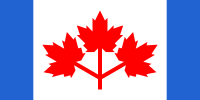Canada Gets New Flag - February 15th, 1965


 Here's your political history lesson for the day: Following Canada's great contribution to the First World War, King George V granted Canada a coat of arms with red and white as the official colours. In 1925 Prime Minister Mackenzie King appointed a parliamentary committee to investigate possible designs for a flag, but it failed to make a formal report. Almost yearly, there would be a debate in the House of Commons on the issue and invariably the debate bogged down on whether or not Canada's flag should be free of colonial symbolism.
Here's your political history lesson for the day: Following Canada's great contribution to the First World War, King George V granted Canada a coat of arms with red and white as the official colours. In 1925 Prime Minister Mackenzie King appointed a parliamentary committee to investigate possible designs for a flag, but it failed to make a formal report. Almost yearly, there would be a debate in the House of Commons on the issue and invariably the debate bogged down on whether or not Canada's flag should be free of colonial symbolism.Immediately after the end of the Second World War, Prime Minister Mackenzie King again appointed a parliamentary committee to consider the matter. English-speaking MPs demanded that the Union Jack form part of the flag, while French-speaking MPs wanted it eliminated. The committee hoped that its compromise which reduced the size of the Union Jack and added a gold maple leaf on a white background would satisfy everyone. It did not. In fact, the government of Maurice Duplessis passed a motion in the Quebec Legislature demanding that all 'foreign symbols' be excluded from any Canadian flag. When some Quebec Liberal MPs, including Jean Lesage (later premier of Quebec), threatened to vote against the government if it moved to adopt the recommendation, King quietly allowed the matter to drop. The matter remained unsolved largely because some Canadians wanted Canada's symbols to reflect its British heritage while others wanted them to be Canadian.
When he became prime minister in 1963, Lester B. Pearson, the Nobel-prize winning diplomat for his peacekeeping initiatives, wanted a distinctively Canadian flag. He had promised in the Liberal party platform in 1961 that a Liberal government would 'establish a distinctive Canadian flag within two years of taking office.' Unlike previous prime ministers, Pearson was committed to a new flag and, despite the political risks to his government, he ask heraldry experts to work on the flag. He favoured a flag with 3 maple leafs on a white background with a blue bar on each side. When Pearson introduced this flag at a Canadian Legion in Winnipeg on 17 May 1963, he was jeered and howled down by a angry group of veterans and created a storm of protest in parliament and across the country.
The Progressive Conservatives under former Prime Minister John Diefenbaker wanted a flag that honoured the French and British heritage; the New Democratic Party wanted a single maple leaf. The views varied across the country. A columnist in Toronto wrote that Pearson's design is 'a rag of appeasement, thrust upon us by a dictator who has split the country.' A letter to the Toronto Star said 'If all Canadians will fight as vigorously under the new flag as they have over it, there is still hope for us as a great nation.'
Pearson appointed Liberal MP John Matheson to chair a special parliamentary committee to bring a proposal to parliament. It proposed the current flag of a single maple leaf on a white background with two red banners on either side, but that, of course, did not settle the matter. After a lengthy parliamentary debate that tied up government for nearly six months, the government invoked closure to end debate and forced the members of parliament to vote. In the end, the 163 Liberals voted for the current flag; the 73 Conservatives were opposed.
On 15 February, 1965, the red maple leaf was flown for the first time as Canada's official flag and, despite some lingering opposition, an issue that had plagued governments for generations had been finally resolved. The Maple Leaf quickly became a powerful Canadian symbol, showing how much Canada had changed in a single generation.
From 'The Flag Debate'










why is canada's new flag so important to canadian history?
Posted by Unknown |
5:01 pm, January 18, 2010
Unknown |
5:01 pm, January 18, 2010
By removing all of the 'British monarchy' bits .. it sorta expresses that we were not attached to England as we had been.
Posted by leftdog |
9:34 pm, March 21, 2010
leftdog |
9:34 pm, March 21, 2010